Coronavirus (COVID-19): state of the epidemic - 28 January 2022
This report brings together the different sources of evidence and data about the Covid epidemic to summarise the current situation, why we are at that place, and what is likely to happen next.
This document is part of a collection
Estimated Infection Levels and Case Numbers
Estimated Infection Levels
The reproduction number (R) is the average number of secondary infections produced by a single infected person. If R is greater than one the epidemic is growing, if R is less than one the epidemic is shrinking. The higher R is above one, the more people one infectious person might further infect other people and so the faster the epidemic grows. Please note that R is an indicator that lags by two or three weeks. For more information please visit the UK government website.
The UK Health Security Agency's (UKHSA) consensus estimate for R in Scotland as at 11 January 2022 is between 0.7 and 0.9 (Figure 1)[2] [3]. The upper limit of the R value has decreased since the last published R value, while the lower limit has remained unchanged.
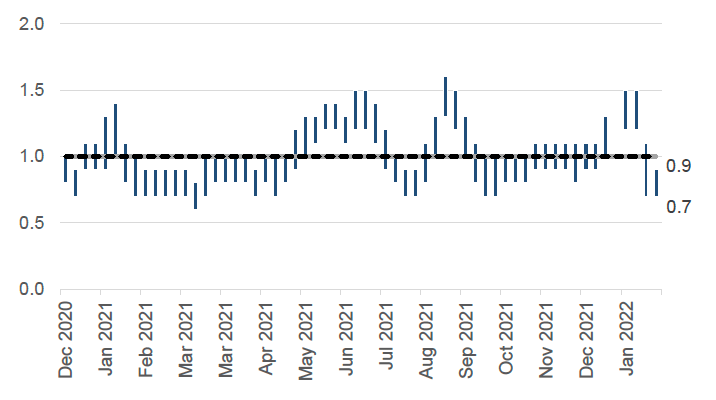
The growth rate reflects how quickly the numbers of infections are changing day by day. It is an approximation of the percentage change in the number of new infections each day. More information can be found on the UK government website.
The latest growth rate for Scotland as at 11 January 2022 was between -8% and -2%[5]. The upper limit has decreased since the previous week, while the lower growth limit remains unchanged[6]. As at 11 January, the incidence of new daily infections in Scotland was between 47 and 572 new infections per 100,000 people[7]. This equates to between 2,600 and 31,300 people becoming infected each day in Scotland.
Covid Infection Survey
The Covid-19 Infection Survey is a UK wide study carried out by the Office for National Statistics (ONS) and the University of Oxford. The survey invites private residential households to test whether they have the infection, regardless of whether they have symptoms, using a PCR test. Participants are also asked to provide a blood sample to test for antibodies. This means the study is unaffected by testing policy changes mentioned at the start of this report.
In Scotland, the percentage of people testing positive for Covid-19 in the private residential population continued to decrease in the week 16 to 22 January 2022 to 3.11% (95% credible interval: 2.73% to 3.50%)[8], equating to around 1 in 30 people (95% credible interval: 1 in 35 to 1 in 30). Despite the decreasing trend, this is still higher than the latest peak of 2.29% recorded in the week to 11 September 2021, and higher than the previous peak of 1.24% recorded in the week to 17 July 2021.
The decrease in the ONS Covid-19 Infection survey results for Scotland aligns with the overall decreasing trend in early January in both PCR confirmed cases and in PCR and LFD reported cases.
In the week 16 to 22 January 2022, estimates for the other nations of the UK are as follows and can be seen in
Figure 2.
- In England, the percentage of people testing positive in private residential households continued to decrease: 4.82% (95% credible interval: 4.66% to 4.98%), equating to around 1 in 20 people (95% credible interval: 1 in 20 to 1 in 20).
- In Wales, the percentage of people testing positive in private residential households continued to decrease: 3.27% (95% credible interval: 2.74% to 3.85%), equating to around 1 in 30 people (95% credible interval: 1 in 35 to 1 in 25).
- In Northern Ireland, the trend in the percentage of people testing positive in private residential households is uncertain: 5.26% (95% credible interval: 4.45% to 6.14%), equating to around 1 in 20 people (95% credible interval: 1 in 20 to 1 in 15)[9].
In Scotland, the trend in the percentage testing positive for COVID-19 was uncertain for those of nursery or primary school age, and there was a decrease for those of secondary school age, young adults and older age groups[10].
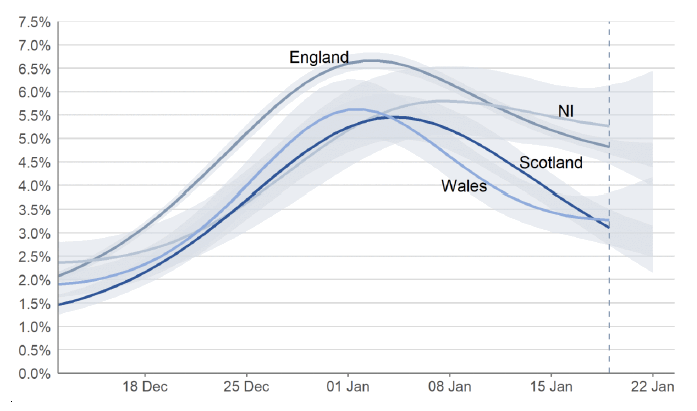
Wastewater Estimates
The Scottish Government has been working with the Scottish Environment Protection Agency (SEPA) to detect and analyse fragments of Covid-19 virus RNA in wastewater. The number of locations where the levels of SARS-CoV-2 in wastewater are monitored has increased to 141 sites around Scotland. In contrast to Covid-19 case records, virus shedding into wastewater is a biological process. This means that wastewater data is unaffected by factors that impact whether testing is done.
Nationwide, wastewater Covid-19 levels have declined greatly from their peak just before the new year, with a decrease to around 50 million gene copies per person per day in the week ending 24 January 2022[11].
Compared to the situation before December 2021, wastewater Covid-19 levels appear lower than anticipated given the known levels of Covid-19 activity. This effect may be due to the switchover from Delta variants to the new Omicron variant. Thus, Figure 3 shows only data from after the end of 2021, at which point the Omicron variant already represents the vast majority of cases in Scotland. From this, we see a rapid decline from peak levels in early January with a continued albeit slower decline up to this point[12].
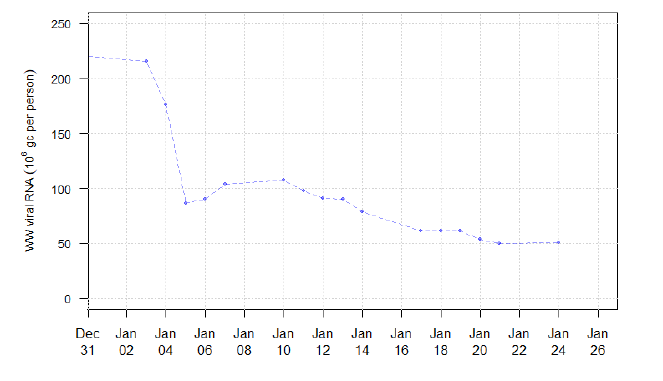
Comparing the weeks beginning 11 January and 18 January, there was an increase in Covid-19 levels in wastewater in five local authorities: Edinburgh, Dumfries and Galloway, East Lothian, Midlothian and West Lothian[14].
Covid-19 Cases
Please note that on 5 January 2022 people were advised that they no longer need to seek a confirmatory PCR test following a positive lateral flow test. This will impact the number of cases reported from 6 January 2022. This means that comparisons over time need to be made with caution. The Omicron variant now represents the dominant variant in Scotland1. For more information on the emergence of the Omicron variant, see earlier publications.
The seven-day average number of combined PCR or LFD daily reported cases has been fluctuating since mid-January 2022. By reporting date[15], an average number of 7,428 cases confirmed by either a PCR or LFD test[16] were reported per day in the week leading up to 26 January 2022. This a 1% increase from the daily average of 7,360 cases reported in the week leading up to 19 January 2022 (Figure 4)[17].
Further analysis shows that different types of testing show different trends. The seven-day average of daily reported PCR only cases decreased by 16% in the week leading up to 26 January. By contrast, the seven-day average of daily reported LFD only cases increased by 33% in the same week.
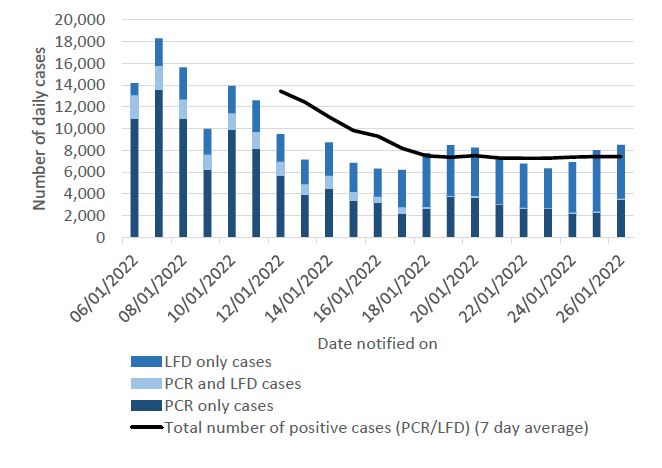
By specimen date[19], seven day PCR case rates decreased in Scotland in the week leading up to 23 January. There were 480 weekly PCR cases per 100,000 population in the week to 23 January 2022, which is a 17% decrease from 575 weekly cases per 100,000 on 16 January (Figure 5)[20]. Covid case data that combines PCR and LFD test results are not yet available by specimen date following the change in testing policy on 5 January, so the figures above and in Figure 5 only include PCR test results and caution must be exercised interpreting these figures.
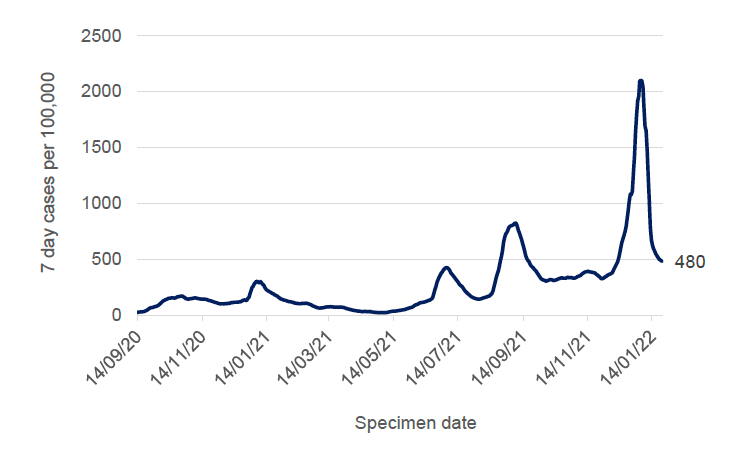
Breakdowns by age (for all age groups) of Covid case data that combines PCR and LFD test results by specimen date are not yet available, therefore the following age breakdowns only include test results by reporting date.
Combined PCR and LFD daily cases by reporting date (as per data from the PHS Daily Dashboard) have been fluctuating in all age groups since around mid-January, with the daily case rates having decreased in all age groups apart from those aged 14 or below in the period from 6 January to 26 January. Among those aged 14 or below, the daily case rate has increased from 161 daily cases per 100,000 on 6 January to 341 daily cases per 100,000 on 26 January 2022 (Figure 6)[21].
Data from the PHS Daily Dashboard shows that as of 26 January 2022, the highest combined PCR and LFD daily case rates by reporting date per 100,000 population were observed amongst those aged 0-14 and 25-44, followed by those aged 15-19, 20-24, 45-64, and those aged 85 and over. The lowest total daily combined PCR and LFD case rates per 100,000 were in the age groups 65-74 and 75-84.
In the last week leading up to 26 January, total combined PCR and LFD daily case rates per 100,000 have increased in all age groups except for those aged 15-19 and 45-64. The biggest increase in daily case rates over this week was seen among those aged 85 and above, increasing from 72 daily cases per 100,000 population on 19 January to 83 daily cases per 100,000 population on 26 January 2022[22]. This is a 15% increase over the last week. There was also a 5% increase in the case rate for those aged 14 or below over this week, increasing from 326 daily cases per 100,000 population on 19 January to 341 daily cases per 100,000 population on 26 January.
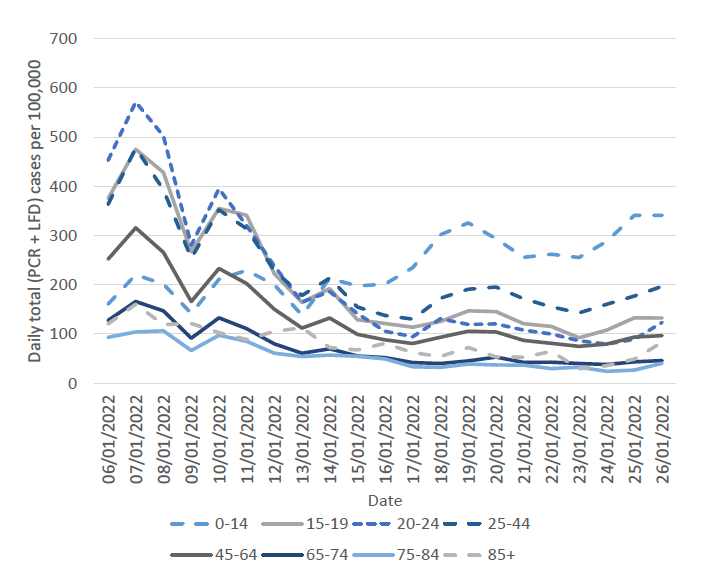
The trend seen among those aged 14 and below from the PHS daily dashboard aligns with data published on the PHS Education dashboard, which provides a weekly combined PCR and LFD case rate by specimen date. The highest total combined PCR and LFD weekly case rates by specimen date among children and young people (aged under 22) in the week to 23 January 2022, were observed among those aged 5-11, followed by 12-15 and 2-4.
Total combined PCR and LFD weekly case rates per 100,000 among children and young adults have increased for all age groups younger than 16 compared to the previous week (ending 16 January), with the biggest increase seen among those aged 5-11. In this age group, the weekly combined PCR and LFD case rate increased from 1,654 weekly cases per 100,000 in the week to 16 January to 2,794 weekly cases per 100,000 in the week to 23 January. Case rates have decreased for the age groups 16-17, 18-19 and 20-21 in the week leading up to 23 January, compared to the previous week. All younger age groups (aged under 22) now have a higher seven day combined PCR and LFD case rate than the Scotland level in this time period[24].
While it may be helpful to compare case rates between the UK nations, comparisons must be made with caution due to definitional differences. Cases data from Scotland and Wales used below includes only PCR test results. Cases data from Northern Ireland includes both PCR and LFD results, and cases data from England includes PCR, LFD and LAMP (loop-mediated isothermal amplification) test results.
By reporting date[25], Scotland's seven-day average daily cases were 685 per one million population in the week leading up to 26 January 2022. In the same time period, the average daily cases by reporting date were as follows for the other UK nations[26]:
- England: 1,456 per one million
- Northern Ireland: 2,059 per one million
- Wales: 768 per one million[27].
By specimen date, Scotland's seven-day average daily cases were 707 per one million population in the week leading up to 21 January 2022. In the same time period, the average daily cases by specimen date were as follows for the other UK nations[28]:
- England: 1,423 per one million
- Northern Ireland: 2,085 per one million
- Wales: 724 per one million[29].
Testing Rates and Positivity
After a period of increase, the seven day total of conducted PCR tests per 1,000 populations peaked at 83 on 7 January 2022, and has since decreased to 32 on 26 January. Showing a similar trend, the proportion of positive PCR tests in the last seven days (test positivity rate) reached 29.4% on 4 January and then sharply decreased to 17.9% on 18 January. The PCR test positivity rate has since plateaued with slight fluctuations throughout the most recent week, with a 17.5% PCR positivity rate on 26 January[30]. Please note that caution must be exercised when interpreting these figures following changes to the testing policy on 5 January 2022.
After a decrease in the number of LFD tests that were reported between 27 December 2021 and 9 January 2022, there was a 7% increase in the number reported in the week leading up to 16 January 2022[31]. In the week leading up to 23 January, the number of reported LFD tests decreased by 1%, remaining similar to the previous week. This follows a sharp increase in LFD tests that were reported throughout December 2021 (Figure 7)[32].
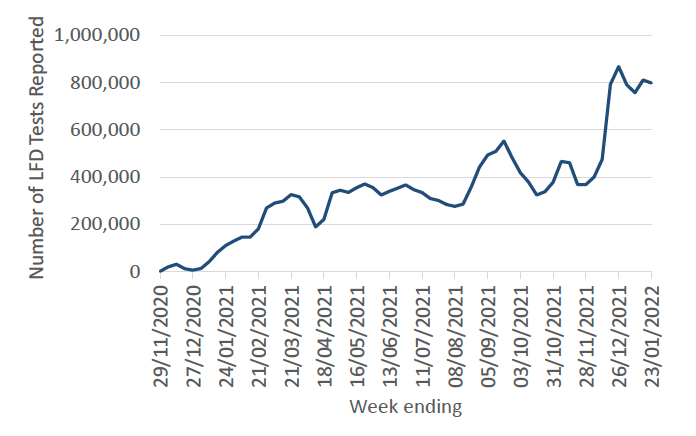
YouGov survey results have shown that on 18-19 January, 58% of respondents had taken a LFD test and 10% a PCR test in the past week[33]. Of those who had taken a LFD test, 47% recorded the result of their last LFD test online and 48% did not record the results online[34].
Scottish Contact Survey asks whether people use Lateral Flow Device tests and if so how often. Approximately 76% of individuals had taken at least one lateral flow test within the last 7 days for the survey pertaining to the 13 - 19 December, decreasing from 86% two weeks prior[35].
Contact
There is a problem
Thanks for your feedback